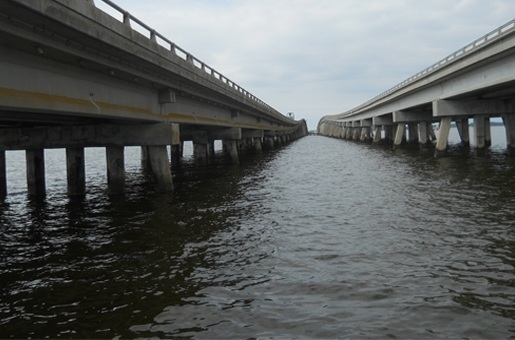
NCDOT – Wright Memorial Bridge
About the Wright Memorial Bridge
Opened in the 1930s, the Wright Memorial Bridge carries today millions of travelers every year across the Albemarle Sound. The 4 lane bridge spans the three mile gap of Albemarle Sound between mainland Currituck County and the barrier island beaches of Dare County. Virtually every visitor who travels to the Outer Banks from Virginia and all states north will cross over the bridge along their route.
Condition Assessment, Service-Life Evaluation & Intervention Strategy
SIMCO was hired by the North Carolina Department of Transportation (NCDOT) to perform a materials condition evaluation, and to determine the remaining service life of the Wright Memorial Bridge over Currituck Sound. The results would be used as part of an evaluation for rehabilitation and/or reconstruction options for the concrete elements.
SIMCO’s scope of work consisted in on-site observations and coring, laboratory testing and numerical modeling. The results of the analysis were used to establish a repair and maintenance program to extend the service life of the structure by 30 years.
A durability analysis was performed for each investigated element. Calculations were also performed using SIMCO’s STADIUM numerical modeling software to determine the applicable exposure conditions by reproducing the experimental chloride profiles. The results were consistent and indicated a general decrease in chloride exposure and humidity with increasing distance from the water surface.
Subsequently, with the use of exposure conditions specific for the bridge, calculations were made for a period of 50 years into the future to evaluate the risk of future concrete degradation (i.e., mainly chloride ingress and determination of the time to corrosion initiation at reinforcement depth). The option of doing nothing was first investigated. Based on these calculations, corrosion has initiated or will initiate within the next 50 years for: the deck shoulders, the Type I pile caps, the bottom portion of the piles, the columns and the footings. The traffic lanes, the beam webs, the Type II pile caps are not expected to exhibit widespread corrosion-related damage. It remains however possible that corrosion develops in small areas of these elements where local conditions favor corrosion initiation, such as water accumulation and/or low cover.
Different repair methods were considered and calculations were performed with STADIUM to evaluate the durability of the different options. The calculations were performed for a single repair material, which was selected because it offered a good compromise between high resistance to chlorides and compatible properties with the original concrete.
Based on the calculation results and cost estimates, a detailed repair program aimed at maintaining the structure in good condition for the next 30 years, was developed for each element. In many cases, the repair options were adapted to the different sections of the elements. The total estimated cost of the repair program is slightly above 31 million dollars. A recommended time frame was provided for the repairs and priorities were established. The complete program is to be spread over the next 10 years, with maintenance repairs performed every 5 years.
Quick Fact
A detailed repair program was elaborated to maintain the structure in good condition for the next 30 years, with a total estimated cost slightly above 31 million dollars. Priorities were established for the next 10 years, with maintenance and repairs performed every 5 years.


